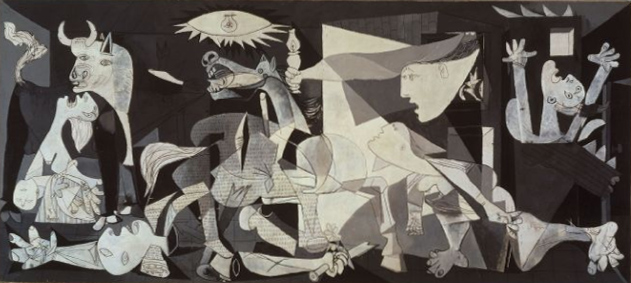
- •I ntroduction
- •1.1. The arts
- •1.2. What is art?
- •What is art?
- •1.3. Revision
- •2.1. Man and music
- •2.2. Understanding music
- •Understanding music
- •2.3. Describing music
- •2.4. Describing a music event
- •A Feast of Russian Arts
- •2.5. Mozart’s don giovanni opens in prague
- •Mozart’s don giovanni opens in prague
- •2.6. The story of jazz
- •The story of jazz
- •2.7. Revision
- •3.1. Describing a painting
- •3.2. British landscape painters
- •3.3. Landscape painting
- •Landscape painting
- •3.4. Impressions of light
- •3.5. Édouard manet
- •Édouard Manet – not just an impression
- •3.6. Modern art
- •Adapted from Wikipedia, the free encyclopedia
- •3.8. American pop art painters
- •3.9. Revision
- •4. Check yourself
- •Writing a formal letter
- •Ways of salutation
- •Ways of closing a formal letter
- •Reviewing songs and music
- •Writing a film review
- •Understanding the task
- •Word formation
- •Structuring a review
- •Intensifying adverbs
- •Words that go together
- •Link words
- •Planning
- •Writing
- •Checking
- •Reviewing a song
2.7. Revision
SPEAKING
Task 1. My favourite music style.
Prepare a presentation about your favourite music style.
Cover the following:
When, where and why did this music style appear?
What are the brightest music performers/ singers within this style? What performer/ singer is your favourite one? Why?
How does the music of this style sound? What instruments are typical of this music style?
Why do you like this music style? When do you listen to this kind of music?
Unit 3. painting
VOCABULARY PRACTICE
3.1. Describing a painting
Task 1. Study the given vocabulary.
Painters and their craft: a fashionable/ self-taught/ mature artist; a portrait/ landscape painter; to paint from nature/ memory/ imagination; to paint mythological/ historical subjects; to specialize in portraiture/ still life; to portray people/ emotions with moving sincerity/ with restraint; to depict a person/ a scene of common life/ the mood of...; to render/ interpret the personality of...; to reveal the person's nature; to capture the sitter's vitality/ transient expression; to develop one's own style of painting; to conform to the taste of the period; to break with the tradition; to be in advance of one's time; to expose the dark sides of life; to become famous overnight; to die forgotten and penniless.
Paintings. Genres: an oil painting; a canvas; a water-colour/ pastel picture; a sketch/ study; a family/ group/ ceremonial/ intimate portrait; a self-portrait; a shoulder-length/ half-length/ knee-length/ full-length portrait; a landscape; a seascape; a genre/ historical painting; a still life; a battle piece; a flower piece; a masterpiece.
Composition and drawing: in the foreground/ background; in the top/ bottom/ left-hand corner; to arrange symmetrically/ asymmetrically/ in a pyramid/ in a vertical format; to divide the picture space diagonally; to define the nearer figures more sharply; to emphasize contours purposely; to be scarcely discernible; to convey a sense of space; to place the figures against the landscape background; to merge into a single entity; to blend with the landscape; to indicate the sitter's profession; to be represented standing/ sitting/ talking; to be posed/ silhouetted against an open sky/ a classic pillar /the snow; to accentuate smth.
Colouring. Light and shade effects: subtle/ gaudy colouring; to combine form and colour into harmonious unity; brilliant/ low-keyed colour scheme; the colour scheme where ... predominate; muted in colour; the colours may be cool and restful/ hot and agitated/ soft and delicate/ dull, oppressive, harsh; the delicacy of tones may be lost in a reproduction.
Impression. Judgment: the picture may be moving, lyrical, romantic, original, poetic in tone and atmosphere; an exquisite piece of painting; an unsurpassed masterpiece; distinguished by a marvellous sense of colour and composition.
The picture may be dull, crude, chaotic, a colourless daub of paint, obscure and unintelligible, gaudy, depressing, disappointing, cheap and vulgar.
Task 2. Using expressions from Task 1, describe a painting, in which:
the painter reveals the ills of life;
the painter depicts the emotions of a person very vividly;
a person is depicted from head to foot, and in the background there is a tapestry;
an area of countryside or land is shown;
the sea is shown;
an arrangement of objects, for example flowers or fruit, is depicted;
objects in the background are a little blurred;
contours are accentuated;
all depicted objects form a unity;
small wooden houses can hardly be noticed because they are too similar in colour to the background;
bright colours predominate;
subtle colours predominate;
one can hardly make out what is depicted there.
Task 3. Describe one of these paintings in as much a detailed way as you can. Use the plan and the vocabulary from Task 1.
Leonardo da Vinci. Mona Lisa. 16th century. |
Claude Monet. The Cliffs at Etretat. 1885. |
Pablo Picasso. Guernica. 1937. |
|
WATCHING&SPEAKING



